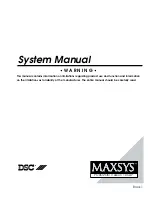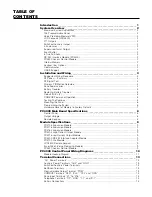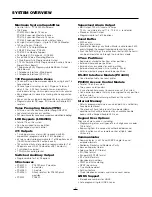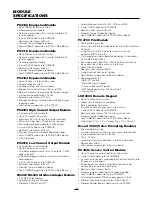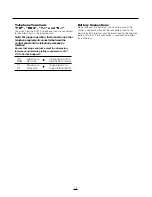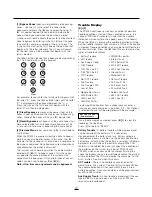
4
11
The PC4216 module provides up to 16 programmable
outputs. Each output can be programmed for 28
different options (See PGM Output List). It is also
used to display zones/status on a graphic
annunciator. Each of the 9 PC4216 modules is
capable of being programmed in any of the 25
available ways indicating the location of the PC4216
and the module number and also be programmed as
custom groups with the 28 options available.
See “PC4216 OPTIONS” for a list of the programming
options.
12
Indicate the location of RS-232 printer module
(PC4400) on the diagram. The PC4400 provides serial
output to an on-site printer that will record the identity
of the system, description of the occurrence (alarm,
trouble etc.) by user, with date and time stamp.
13
13
13
13
13 Indicate on the diagram the location of the PC4820.
On the diagram also include the zones that will be
used as access control points. Indicate the door
number and the location of the card reader as well as
other devices that may be used for the other inputs
(REX - Request to Exit, Post - Postpone Arming, and
Arm - Request to Arm). Depending on the setup of the
installation, these devices may be inside or outside of
the controlled area. Be sure to locate the module
cabinets in a dry, secure location near a non-
switched AC source and ground connection.
Note: When deciding which zone to use for access
control, do not select any zones from 1 to 16.
These zones can only be used as control panel
inputs.
14
Mount the cabinet, panel (See “Mounting The Panel”)
and prepare the wires for connection to the panel.
RF Zones — Summary
Placing Components
Before permanently mounting components, each
component should be tested in its intended mounting
location to ensure it can communicate properly with the
PC4164. It is recommended that the RF Signal Test is
performed more than once for each zone.
For the best system performance, it is suggested that the
PC4164 be mounted in as central location as possible
and as elevated a location as possible.
In most installations, selecting a central location for the
PC4164 will ensure reliable system operation. When
mounting the PC4164 in a basement, it is recommended
that the PC4164 be mounted as high and as close to the
underside of the first floor as possible.
RF Signal Test
Enter installer mode and select the section RF Signal
Test. This section will help determine if the location of the
zone is good. (Be sure that the zone is enrolled before
performing an RF Signal Test). Once this section has
been selected the panel will then ask the user to select
the zone to be tested. Use the [<][>] keys to scroll the
selected zone and press the [
✱
] key to select the zone.
At this point the display will read "Please Activate Zone".
Open and close the zone 2 times. (Note: the zone may
require to be tripped more depending on the location of the
zone). On the restoral of the zone for the second time the
panel will display a rating of the zones placing (with
respect to RF strength). The "Placement Result" may be
Good, Fair, or Poor. A placement rating of "Good" means
that the zone is placed in a location that has strong RF
transmission strength. A placement rating of "Fair" means
that the zone is placed in a location that has passed the RF
transmission strength test. A placement rating of "Poor"
means that the zone is placed in a location that has weak
RF transmission strength and therefore should be
relocated. In most cases it should only be necessary to
move the component a short distance from is original
intended location.
After relocating the component repeat the RF Signal Test.
When the test results are satisfactory continue to test the
next component.
Note: To perform a RF Signal Test on an RF PIR Motion
Detector the zone must be tampered and restored
instead of opened and closed due to the detectors
"High Traffic Shutdown Mode".
Wireless PIR Motion Detectors
To prolong battery life of a PIR Motion Detector, the
detector features a High Traffic Shutdown Mode. If a motion
detector is activated more than once within a 6 minute
period, the detector will temporarily delay reporting activity
to the PC4164. The Motion Detector will then require a 12
minute period of no activity before it will resume
transmissions to the PC4164. Because the High Traffic
Shutdown Mode prevents Motion Detectors from being
tested during a regular walk test, the Motion Detector
features its own built-in Walk Test Mode. To activate this
mode remove the back plate from the detector to be tested,
and then re-attach it. The Motion Detector will be in Walk
Test Mode for 90 seconds. The LED will come on for 3
seconds each time the detector is tripped. (Note: The zone
will not transmit the zone trip to the PC4164 during this
mode. To perform a walk test of the Wireless PIR the zone
must be tampered and restored). At the end of the 90
second period the Motion Detector will return to normal
operation.
Zone Supervisories
A zone supervisory is a transmission sent from the wireless
zone to the PC4164 as a test transmission to ensure that
communications between the zone and the PC4164 are still
present. When the PC4164 receives the supervisory from
the zone it will then transmit this information to the control
panel. If the control panel does not get a supervisory within
the "supervision time", the zone will be considered lost and
go into the open state..(if Double EOL is being used the
zone will go into the Tamper Alarm state). If the partition
partition is armed the zone will go into alarm and transmit
the sensor fault and alarm reporting codes if programmed.
The next supervisory that the PC4164 receives for a
missing zone will restore communication with that zone and
restore the Zone Supervisory Fault.
Summary of Contents for MAXSYS PC4020NK
Page 15: ...11 Module Hookup Diagram...
Page 35: ......

